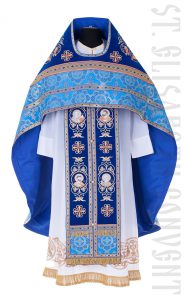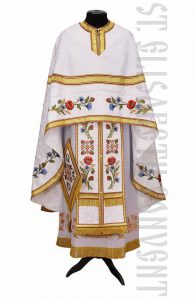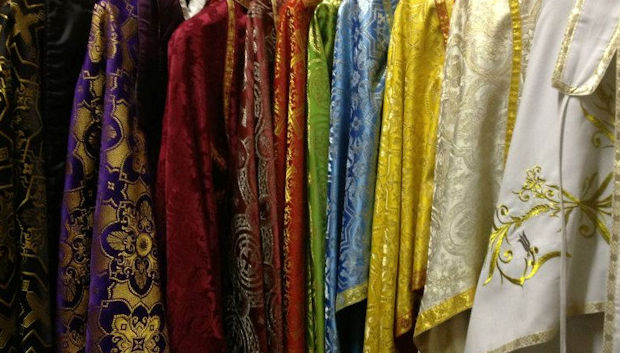Throughout the year, you may notice that the “color scheme” of an Orthodox church changes. The priest’s vestments change from one color to another, as do the altar cloths and other fabrics used throughout the temple. In the Eastern Orthodox Church, these colors mark the feasts and the seasons of the liturgical year. And each color has its own special meaning. In this guide, we walk you through each of the liturgical colors, starting with the color we see the most: gold.
Gold
Gold is the liturgical color for the general season of the Orthodox year. In other words, any time we are not using some other color – like purple, red, or green – we use gold. Because of this, you will see gold liturgical cloths in the church more often than any other color throughout the year.
Gold cloths adorn the church from Christmas to Epiphany, and in some places, during the Nativity fast. Moreover, we use gold liturgical colors for any feasts** or days commemorating Our Lord Jesus Christ, the Prophets, the Apostles and the Holy Hierarchs.

Blue
Orthodox priests wear blue vestments and decorate the temple with blue cloths for all feasts and fasts that commemorate the Theotokos, the bodiless powers, and virgins. The Orthodox Church also uses this color for the Presentation of the Lord, the Annunciation, and in some traditions, the fifth Friday of Lent (Akathist).

Red
Another frequently used liturgical color in the Orthodox Church is red, the color of blood. We decorate the church with red cloths, and the priest wears red vestments, for the following times:
- Any feasts and days commemorating the Cross
- Saints Peter and Paul fast and feast (June)
- Advent fast (November and December)
- Feast days for holy martyrs
- Great and Holy Thursday (dark red)
- Pascha and Nativity (in Moscow, on Mount Athos, and at Jerusalem)
In some places, orange or rust replaces red during the Saints Peter and Paul fast. And in other places, they also continue to wear orange/rust through the Transfiguration (August).

Green
Next, we use green vestments and cloths to mark the feasts of Pentecost (and its post feast) and Palm Sunday, as well as days commemorating angels, prophets, monastic saints, ascetics, and fools for Christ.
In some places, green is worn for the Elevation of the Holy Cross in September. In Carpatho-Russian practice, green is worn from Pentecost until Ss. Peter and Paul fast.

Black/Purple
Black and/or purple are the liturgical colors for Lent. In some traditions, priests will use dark blue, dark green, or dark red. Traditionally, purple is worn only on weekends, while black (with colored ornaments) is worn during the weekdays of the Fast, especially during Holy Week. In some places, however, priest wear purple on weekdays and gold on weekends during Great Lent.

White
The last color in the liturgical cycle for the Orthodox Church is white. As the color of death (and the resurrection) in the Eastern tradition, we use white for funerals and memorial services. Additionally, Orthodox priests wear white for the feasts and post-feasts of Epiphany, Transfiguration, and Pascha. In some places, white is also worn on Christmas Day.

**Please note that when we say “feast,” we include the period from the vigil of the feast until its apodosis. The length of these post-feasts vary, and you can find them in the Liturgical Calendar and Rubrics. Generally speaking, for each of the twelve major feasts there is a post-feast of about a week.

